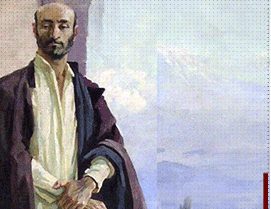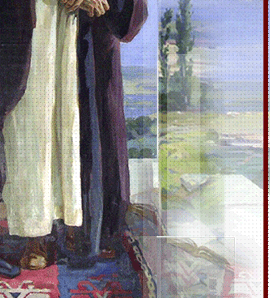| ARRANGEMENTS
OF KOMITAS' COMPOSITIONS
Komitas' ingenuity has always been a source
of inspiration both for performers and composers. Many creators
frequently turn to his delightful musical examples, creating works
in various styles for numerous instrumental combinations. These
treatments of Komitas' themes are fresh, unique and diverse, though the spirit of the great Armenian
classic always appears in each of them.
The author of some prominent works on Komitas' songs was Sergey
Aslamazian, the founder and cellist of the Komitas Quartet. An excellent
performer, he also was a talented composer who enriched the repertoire
of Armenian quartet music. Aslamazian always admired Komitas' art,
and he considered the latter's compositions to be unsurpassable
and perfect models.
For this very reason Aslamazian set to work, feeling greatly responsible
for upholding it. Mastering the secrets and the subtlety of quartet
music, in his works he utilised a maximum of performance possibilities
of the quartet, aiming at absolute harmony and transparent sounding.
"Habrban", "Shogher jan", "Erkinkn ampela",
"Keler-tsoler", "Vagharshapat Dance", and "Kele-kele"
- these works of Aslamazian are accomplished in a highly artistic
way and with excellent knowledge of the technical range of the quartet.
Aslamazian shows an individual approach to each instrument, which
results in colourful sounds. Sometimes one may seem to hear Armenian
folk instruments in his works and not a violin, a viola or a cello.
Using only the means of a standard quartet, Aslamazian obtains the
sound of the kamanche or the tar. His treatments are nationalist
in spirit and it is no wonder that these miniatures are always included
as an integral part of the Komitas Quartet's repertoire. These invaluable
pearls of quartet music are admired not only by professional musicians
but also by amateurs.
Nikolay Myaskovsky, a symphonic composer of the Soviet era, was
right when he said, "These works ought to become a manual for
any composer". And in the opinion of Alexander Arutiunian,
an Armenian composer, "these pearls of Armenian chamber art,
modestly ranked by Aslamazian as arrangements, are made with a delicate
and serious master's hand. This charming cycle, which is likely
to be the musical motto of the Quartet, has been successfully received
so far".
Presently, owing to Aslamazian's treatments, Komitas' art and songs
- and through them, the Armenian people - are known all over the
world. Aslamazian also has treatments for violin and piano, e.g.
"Krunk".
Avet Gabrielian, the first violinist of the Komitas Quartet, did
not remain indifferent to the great composer's songs. In his arrangements
of Komitas' songs "Kakavik" and "Tsirani tsar"
for violin and piano, one can feel a wonderful understanding of
the means of a violin performance.
Arno Babajanian, the outstanding Armenian composer, has his own
version of Komitas' "Vagharshapat Dance" that is included
in the repertoire of many prominent performers.
Another author who worked on Komitas' songs is a noted pianist and
teacher, Robert Andreasian. His musical gift was displayed in the
field of composition as well. Some of his piano arrangements of
Komitas' songs are fascinating. One can easily find in them the
influence of the great composer's fine and laconic style. Andreasian
treats the original music carefully and thoroughly, trying to preserve
the main musical image. Discipline, sincerity, delicacy of feelings,
and reticence penetrate everywhere - into the tragic "Garun
a", the amusing "Kakavik", the delicate "Oh,
Nazan", the lyrical "Abrban", the expressive "Ov
arek", or the dramatic "Tsirani tsar".
Each treatment is a highly accomplished
miniature. Widely using the spectrum of the piano, Andreasian makes
an impression of the sounds of folk instruments. The prominent Armenian
composer Aram Khachaturian said of his works, "They are created
by a true master".
Treatments of Komitas' music by the pianist Georgy Saradjev are
also done with a professional skill. His "Krunk", one
of the admirable samples of Armenian national music, sounds original
and moving.
A treatment of one of Komitas' songs "Ah, maral djan"
for violin and piano is perfectly realised by the performer Aram
Shamshian.
Beyond the fine quartet works by Aslamazian, one should especially
distinguish the works by the modern composer Ruben Altunian. The
created treatment of the song "I've loved" for string
quartet dates from an early period of Altunian's creative work.
More recently, he composed an original treatment of Komitas' song
"Antuni". It is worth mentioning that the composer has
used both a kamanche and a chamber orchestra instead of the traditional
cast of instruments, thus synthesising timbres in an interesting
manner. In the history of Armenian music a unique role is played
by Edgar Hovhannesian's ballet "Antuni", written for the
100th anniversary of Komitas' birth, in which the composer used
Komitas' melodies to describe the images of this great musician
and the Armenian people.
The treatments of Komitas' compositions are also widely used in
the variety genre. Komitas' creative work is an interminable source
which will no doubt inspire future generations for many years to
come.
|


